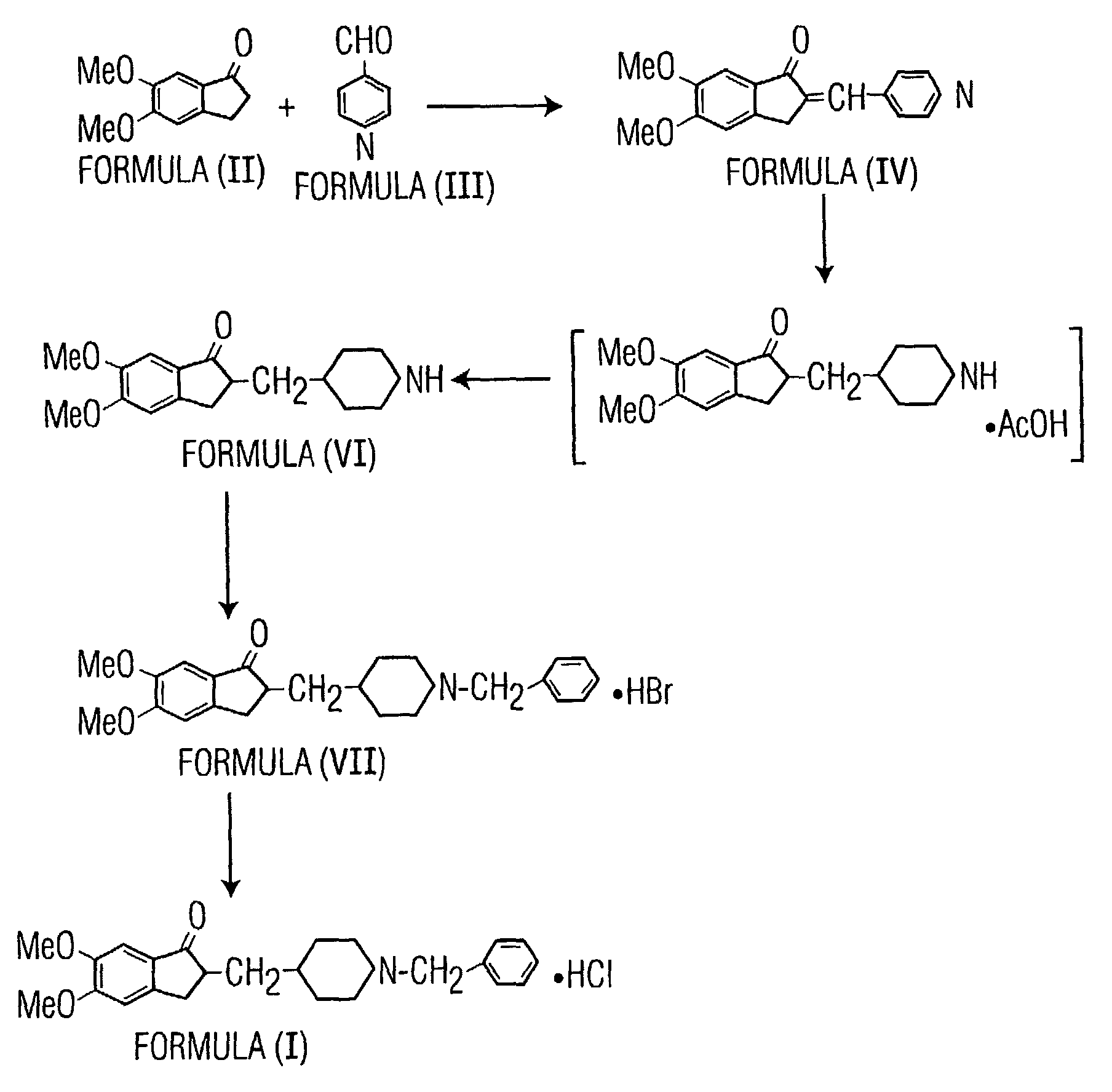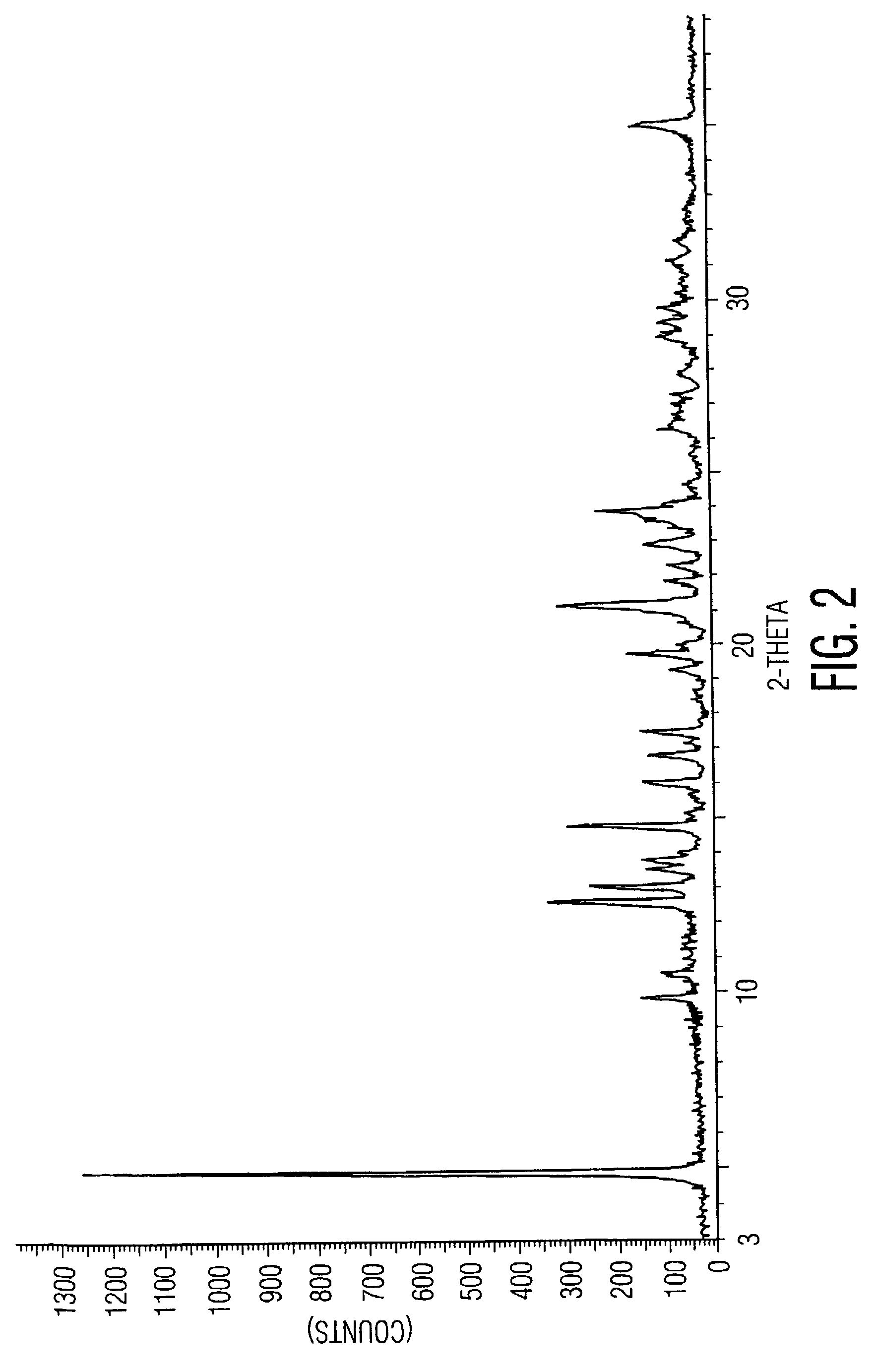Crystalline Form of Donepezil Hydrochloride
a technology of donepezil hydrochloride and crystalline form, which is applied in the field of crystalline form of donepezil hydrochloride, can solve the problems of inability to predict the potential number or even the existence of polymorphs for a given molecule, and achieve the effect of reducing the probability of polymorphs
- Summary
- Abstract
- Description
- Claims
- Application Information
AI Technical Summary
Benefits of technology
Problems solved by technology
Method used
Image
Examples
example 1
Preparation of Donepezil Hydrobromide (VII)
[0055]5,6-dimethoxy-2-piperidin-4-yl-methyl-indan-1-one (200 g), obtained by the process described in International Publication WO 04 / 082685, and sodium carbonate (44 g) were suspended in isopropyl alcohol (400 ml) and methanol (1400 ml) and stirred at a temperature of 55 to 60° C. Benzyl bromide (82 ml) was added slowly dropwise, and the resulting reaction mass was stirred at 55-60° C. for 11 hours. The reaction mass was filtered at 25 to 35° C., and water (3000 ml) was added to the filtrate. The compound was extracted from the resulting aqueous solution at a pH of 7.5-8.2 using toluene (1×2000 ml, 4×1000 ml). The resulting toluene layer was washed with water (3×1000 ml) at 65-75° C. and concentrated under vacuum to produce a residue. The residue was dissolved in methanol (800 ml), heated to 60-65° C., and passed through a celite bed. Hydrobromic acid (70.8 ml) was added at 25-35° C. to the resulting filtrate, which was then cooled to 0 to...
example 2
Preparation of Crystalline Form I of Donepezil Hydrochloride
[0056]Donepezil hydrobromide (13 Kg), 130 L of water, and 156 L of toluene were added to a reactor and stirred for 10-15 minutes at 25-35° C. A 10 percent caustic lye solution was added to the mixture to adjust its pH to between 12 and 14 and the mixture was then heated to 45-50° C. for 10-15 minutes by using hot water circulation. The reaction solution was allowed to settle at 45-50° C. for 10-15 minutes. The aqueous layer was separated and was charged into a reactor containing 65 L of toluene and stirred at 25-35° C. for 10-15 minutes. After another 10-15 minutes without stirring, the reaction mass was transferred into clean HDPE drums. 5% sodium hydrosulfite solution (65 L) was added to the reaction mass and was stirred for 10-15 minutes at 25-35° C. Then the organic layer was separated. Another portion of the sodium hydrosulfite solution (65 L) was added to the organic layer, with subsequent stirring for 10-15 minutes a...
example 3
Preparation of Crystalline Form I of Donepezil Hydrochloride
[0058]Donepezil hydrobromide (50 g), water (500 ml), and toluene (600 ml) were placed in a round bottom flask and stirred for 10-15 minutes at ambient temperature. A 10 percent caustic lye solution was added to the reaction mass to adjust its pH to between 12 and 14, and then the reaction mass was heated to 60-65° C. for 10-15 minutes. The aqueous layer was separated and extracted with toluene several times. The combined organic layers were washed with a 5% sodium hydrosulfite solution (2×250 ml) followed by washing with water. The organic layer was distilled to produce a syrup or residue. The syrup or residue was dissolved in methanol (200 ml), carbon was added, and the methanol was refluxed. The refluxed methanol solution was filtered through a celite bed and washed with methanol. Concentrated aqueous HCl (15.8 ml) was added to the filtrate under continuous stirring and the filtrate was then cooled to 0-5° C. Methyl tert-...
PUM
| Property | Measurement | Unit |
|---|---|---|
| weight percent | aaaaa | aaaaa |
| temperature | aaaaa | aaaaa |
| temperature | aaaaa | aaaaa |
Abstract
Description
Claims
Application Information
 Login to View More
Login to View More - R&D
- Intellectual Property
- Life Sciences
- Materials
- Tech Scout
- Unparalleled Data Quality
- Higher Quality Content
- 60% Fewer Hallucinations
Browse by: Latest US Patents, China's latest patents, Technical Efficacy Thesaurus, Application Domain, Technology Topic, Popular Technical Reports.
© 2025 PatSnap. All rights reserved.Legal|Privacy policy|Modern Slavery Act Transparency Statement|Sitemap|About US| Contact US: help@patsnap.com



